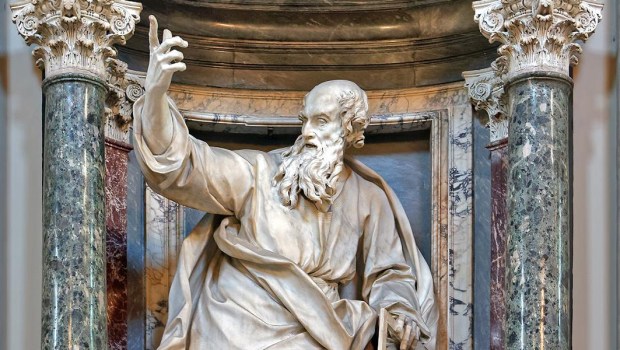Art historian Elizabeth Lev continues her look at Rome-based art that confronted the Reformation.
Lenten Campaign 2025
This content is free of charge, as are all our articles.
Support us with a donation that is tax-deductible and enable us to continue to reach millions of readers.
On the 500th anniversary of the Protestant Reformation, this series of articles looks at how the Church responded to this turbulent age by finding an artistic voice to proclaim Truth through Beauty. Each column visits a few Roman monuments and looks at how art was designed to confront a challenge raised by the Reformation with the soothing and persuasive voice of art.
Like the sudden storms on the sea of Galilee, Rome was rocked by powerful gales of doubt after the Protestant reformation. Martin Luther’s rejection of penitential practice had taken place on Rome’s Holy Stairs when he decided that “the just shall live by faith alone.” In his wake, the Real Presence in the Eucharist was denied, along with the role of the papacy and the magisterium. The barque of Peter seemed fractured in an ever-increasing number of pieces and the faithful wondered which plank to cling to for eternal life. Doubt brought darkness and loneliness, casting a pall over the Eternal City.

Read more:
When art came to the rescue: Making penitence look good
There are few places where the Catholic Church responded as beautifully and compassionately through art than to the problem of doubt. Public and private works emphasized the universality of human doubt, but also underscored the importance of maintaining the faith even during the most unsettling squalls.
The first space to actively address the problem of doubt in art was none other than St Peter’s Basilica.
Built on the tomb of the first pope, who had experienced both fear and denial, but had doggedly returned to offer his life in witness to the truth of Christ, the basilica had just been rebuilt and Michelangelo’s new dome completed in 1590. The decorative plan was entrusted to the Oratorian Cardinal Cesare Baronius, author of a new Church history and editor of the Roman martyrology.
Cardinal Baronius confronted the issue of doubt at the very threshold of the church. The old basilica had boasted the “navicella” mosaic designed by Giotto in the entrance courtyard. Seen by countless pilgrims, it illustrated Matthew 14:28-31 when Peter, seeing Christ out walking upon the waters of the stormy sea of Galilee said, “Lord, if it be you, bid me come unto thee upon the waters. And he said, Come. And Peter went down from the boat, and walked upon the waters to come to Jesus. But when he saw the wind, he was afraid; and beginning to sink, he cried out, saying, Lord, save me. And immediately Jesus stretched forth his hand, and took hold of him, and said to him, O you of little faith, why did you doubt?”
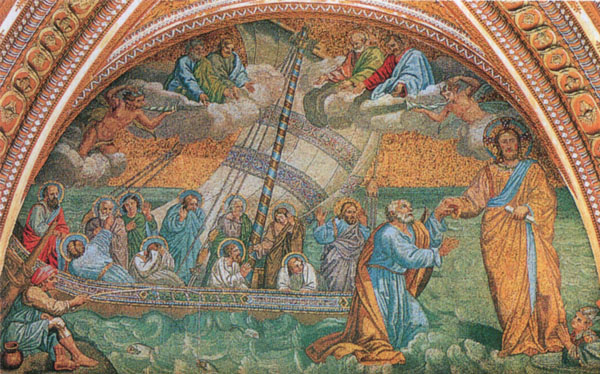
In Giotto’s version from 1310, the crisis has past; Peter holds the hand of Christ who looks calmly towards the viewer as the storm subsides. Baronius kept this image in the courtyard of the new basilica, but for the side entrance, reserved for clergy, he commissioned a new version by Bernardo Castello in 1604, (repainted by Lanfranco in 1627). This new work is more turbulent, with high waves and agitated apostles on the boat. Peter is sinking as Jesus clasps his wrist while pointing upwards towards the first glimmer of serene skies.
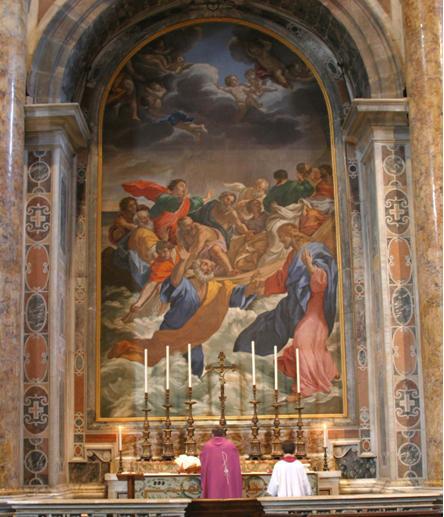
This powerful rendering addressed the clergy just as they entered the Church, encouraging them to leave doubt outside these doors. If the shepherds are not sure-footed, what will happen to the sheep?
Underscoring the theme of doubt, Baronius also commissioned an image of Doubting Thomas for another altar in St Peter’s, closer to the tomb. The present work was originally painted by Domenico Passignano in 1622 and shows a somewhat staid image of the standing, luminous Christ as Thomas reaches towards the wound in his side, while two other apostles huddle over his shoulder. The altar crucifix thrusts into the space between Thomas and Christ, a reminder of what caused those wounds.
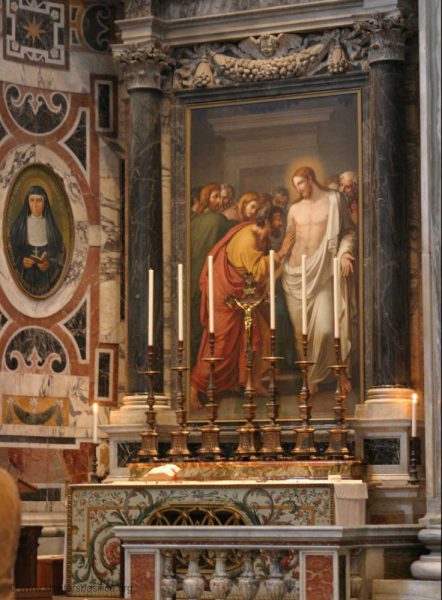
However, St Thomas and the problem of personal doubt was better suited to intimate works rather than large altarpieces. Smaller canvases in private settings allowed the faithful to wrestle with their uncertainties and prepare themselves in the shelter of home for the tsunami of challenges that raged outside the door. Rubens, Guercino, Mattia Preti were among the parade of painters who produced these images, but Caravaggio’s version painted in 1602 for the influential Giustiniani brothers remains the most compelling.
Caravaggio dramatically reduced the size of the image, opening a window on a cluster of four heads that form the shape of a cross. The bodies of the three apostles are lost in shadow drawing attention to their faces, Christ however, stands almost entirely visible before them. In the foreground, Thomas leans close to the wound. His brow is lifted by his astonished eyes, as Jesus guides his finger into His side. This graphic, even disturbing image, accentuated by the rip in the shoulder of Thomas’ tunic, vividly recalls the physical suffering that Jesus endured a week earlier. Yet He stands serene, patient with his friend’s doubt. Jesus brings the light that will open Thomas’ eyes.
Caravaggio’s sympathy with Thomas is evident in the warm colors of gold, russet and burnt orange – this is a true refuge where Jesus knows and accepts human limitation. The two apostles crowded over Thomas’ shoulder suggest that he was not alone in his incredulity, but was the only one who voiced it.
But Caravaggio’s most powerful compositional device is the shadowy little space between Thomas and Christ, in Passignano’s painting occupied by the crucifix, but here meant to be filled by the viewer. As Thomas “the twin” verifies for us, we think of Christ’s words, “Because you have seen me, you have believed; blessed are those who have not seen and yet have believed.” John 20:29
Doubt grew more settled into the human condition when Rene Descartes developed a philosophical method of systematic doubt in the mid-17th century, but the Church had a spectacular response. The culmination of the Roman Baroque saw the most perfect integration of St Thomas into church design, when St John Lateran commissioned a series of 14-foot tall statues of the apostles for the nave.
The statues were placed from 1680-1720 in the large piers that lined the 450-foot nave leading to the altar. In Christian church design, the nave, from the Latin word navis meaning boat, symbolizes the journey of the faithful. These apostles in their niches punctuate that journey, Bartholomew holding his skin, Matthew rejecting his bag of coins, demonstrating their examples of witness. Only one figure however, protrudes from his space to command the attention of the visitor — St Thomas.
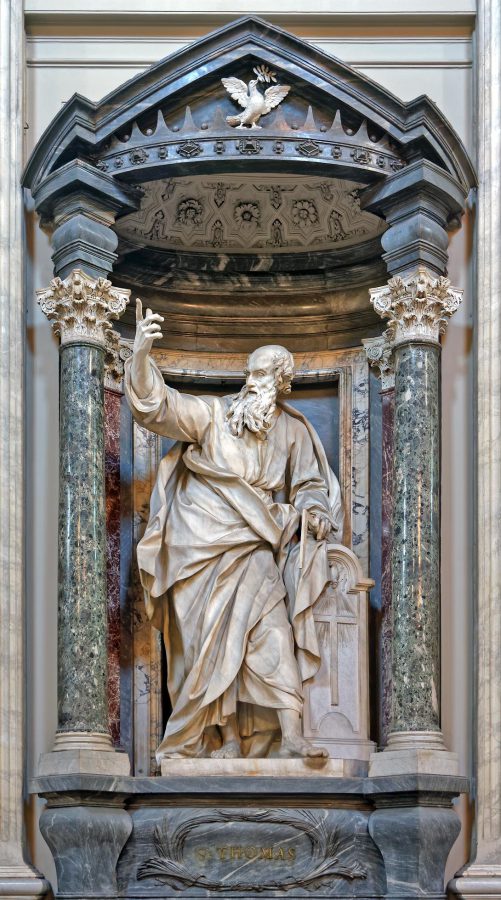
As the Gospels so aptly illustrate, every faith journey hits squalls of doubt, and if midway through the nave our steps falter, there is Thomas, our twin, thrusting that famous finger out to show us the way. For all his doubts and verifications, St Thomas was also the first apostle to proclaim, “My Lord and My God” (John 20:28).
